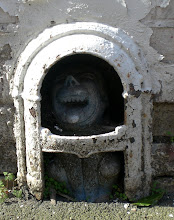 |
| Sutton High Street - Doesn't look that promising but has a surprising number of interesting items throughout its length. The milestone looks a bit forlorn though... |
 |
| Whitehall and the Royal Exchange |

So Brighton it is then, but why would the Brighton Road require so many milestones?
Another quick search revealed a possible answer on the Bobulous website in an article on the history of Sutton
In 1755, a turnpike road from London to Brighton was constructed, intersecting with a turnpike road from Carshalton to Ewell which was constructed at the same time. The toll bars for Cheam Road and Brighton Road were originally located at right angles to each other by the Cock Hotel, an inn that sat on the south-east corner of the intersection of the turnpikes. The toll bar for Carshalton Road was where the police station is now, though the existence of this toll bar is disputed. All three of these toll bars moved further away from the intersection after a number of years to account for the growth in Sutton's size. The northmost toll bar was situated where Rosehill is now. The toll bars remained in effect until 1882.There's an interesting and comprehensive book called "The Brighton Road" by Charles George Harper published in 1922 which actually mentions and describes my earlier milestone on the Brighton Road, along with Belmont's previous nickname of 'Little Hell'! (this canny link to the book will let you read at your pleasure)
It's an interesting book with numerous accounts of Princes, Kings, Nobles and men of letters all eager to make it down to the fashionable resort on the South Coast (and of course as you can see from the note above even the inevitable pugilist turned landlord. 'Gentleman Jackson' owned the Cock coaching inn in Sutton and was a bit of a local celebrity). The toll roads were a good way of cashing in on this popularity and the coaches that plied the route remained the only viable method of transport until the advent of the railways, when they went into steep decline. In its heyday though, if you are important, eager to get back to the City or the Court and had paid top dollar - well I expect decent milestones was the bare minimum you'd expect and might account for their regularity.
It's interesting that although the tolls, the tollbooths, the coaches and even some of the old inns have all gone, the name of the road and the milestones are still tangible reminders of an important part of the Sutton's history.

